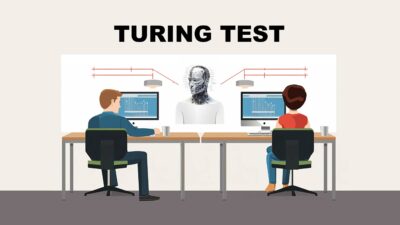The quest to create intelligent machines has captivated humankind’s imagination for centuries, from ancient myths of mechanical men (Metropolis) to modern sci-fi visions of conscious robots (Terminator). But when did this vision begin taking serious scientific steps towards reality? The genesis can be traced back to Alan Turing‘s pioneering 1950 paper, “Computing Machinery and Intelligence” and the Turing Test.
What Is The The Turing Test?
Turing knew that precisely defining “intelligence” was a slippery task, so he proposed an elegant test instead – if a human evaluator could not reliably distinguish a machine’s conversational responses from a human’s, it would indicate the machine is intelligent.

This “Turing Test” avoided tricky definitions and focused on performance capacity. The paper systematically tackled skeptical arguments about machine intelligence, demolishing them one by one. Turing concluded that machines can indeed be programmed to think, given the right representation of knowledge.
The Turing Test’s Influence On Early AI Research
Turing’s paper was a watershed, galvanizing researchers to tackle this visionary challenge. Within a decade, pioneers like Marvin Minsky, John McCarthy, Allen Newell and Herbert Simon founded AI labs at academic hubs like MIT, Stanford and Carnegie Mellon. Each had their own approach – McCarthy using mathematical logic, Newell/Simon modeling human problem solving, Minsky integrating multiple methods. But they shared a fundamental belief – Turing was right, the quest to create thinking machines was viable.
Early programs showed remarkable successes, proving concepts that still underpin AI today. James Slagle‘s system integrated symbolic expressions, implementing “problem reduction” methods to break complex problems into smaller challenges. Other pioneering programs could understand drawings, learn from examples, build structures and even answer natural language questions. A key lesson emerged – the right representation of knowledge enables powerful reasoning. By 1970, AI programs exhibited proficiency once believed unique to humans.
The pace continued through the 1970s, as AI started matching or beating human experts. Edward Shortliffe‘s MYCIN system diagnosed infections as well as physicians using IF-THEN rules encoding medical knowledge. Such “expert systems” dominated the next decade. AI had progressed tremendously in just 20 years, achieving triumphs once considered mythical.
- Lit The AI Spark With Researchers – Turing’s 1950 paper introduced the “imitation game” thought experiment, challenging researchers to create machines that exhibit intelligent behavior indistinguishable from humans. This daring idea galvanized pioneers to tackle the quest to build thinking machines.
- Drove Serious Exploration – By systematically tackling skeptical arguments, Turing established machine intelligence as a viable, scientifically legitimate field of inquiry. His writings inspired early labs to create programs exhibiting reasoning abilities once considered impossible.
- Provided Motivating Goal – The Turing Test gave researchers a hypothetical benchmark to evaluate progress in developing machines that can display human-like conversational aptitude. This motivated key milestones like ELIZA and PARRY which aimed to “pass” the test through the 1960s and 70s.
- Spurred Evaluation Methods – Turing’s imitation game emphasized performance over definitions in assessing intelligence. This perspective influenced evaluation via behavioral tasks central to AI research methodology today. Comparative analysis against human abilities emerged from his framework.
- Catalyzed Knowledge Representation – Encoding knowledge appropriately proved crucial for programs to demonstrate intelligence through reasoning and language use. Turing’s criteria for human-machine equivalence thus catalyzed vital work formalizing critical concepts, relationships and rules needed for AI.
Turing’s visionary paper laid the intellectual foundation for believing machines could think, while subsequent pioneers discovered methods to make this fictional concept real. McCarthy later named the new field as “artificial intelligence” – focused on developing computer models and architectures supporting intelligent thought and behavior. AI emerged through groundbreaking systems exhibiting previously unfathomable mental capabilities. But we are still in the early stages of AI. Exciting times still lay ahead for AI and humanity’s quest to create human-like artificial general intelligence.
The Turing Test's Influence On Early AI Research #history #tech #innovation #AI #TuringTest Share on X










 10 Donut Trivia Facts Too Delicious Not To Share
10 Donut Trivia Facts Too Delicious Not To Share
Leave a Reply
You must be logged in to post a comment.